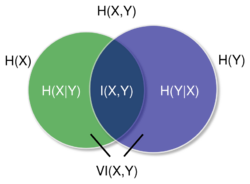Variation of information
 From HandWiki - Reading time: 6 min
From HandWiki - Reading time: 6 min
In probability theory and information theory, the variation of information or shared information distance is a measure of the distance between two clusterings (partitions of elements). It is closely related to mutual information; indeed, it is a simple linear expression involving the mutual information. Unlike the mutual information, however, the variation of information is a true metric, in that it obeys the triangle inequality.[1][2][3]

Definition
Suppose we have two partitions
Let:
Then the variation of information between the two partitions is:
This is equivalent to the shared information distance between the random variables i and j with respect to the uniform probability measure on
Explicit information content
We can rewrite this definition in terms that explicitly highlight the information content of this metric.
The set of all partitions of a set form a compact Lattice where the partial order induces two operations, the meet
Let's define the entropy of a partition
where
Then the VI distance between
The difference
If in the Hasse diagram we draw an edge from every partition to the maximum
For
and we also have that
Identities
The variation of information satisfies
where
where
where
The variation of information can also be bounded, either in terms of the number of elements:
Or with respect to a maximum number of clusters,
Triangle inequality
To verify the triangle inequality
References
- ↑ P. Arabie, S.A. Boorman, S. A., "Multidimensional scaling of measures of distance between partitions", Journal of Mathematical Psychology (1973), vol. 10, 2, pp. 148–203, doi: 10.1016/0022-2496(73)90012-6
- ↑ W.H. Zurek, Nature, vol 341, p119 (1989); W.H. Zurek, Physics Review A, vol 40, p. 4731 (1989)
- ↑ Marina Meila, "Comparing Clusterings by the Variation of Information", Learning Theory and Kernel Machines (2003), vol. 2777, pp. 173–187, doi:10.1007/978-3-540-45167-9_14, Lecture Notes in Computer Science, ISBN:978-3-540-40720-1
Further reading
- Arabie, P.; Boorman, S. A. (1973). "Multidimensional scaling of measures of distance between partitions". Journal of Mathematical Psychology 10 (2): 148–203. doi:10.1016/0022-2496(73)90012-6.
- Meila, Marina (2003). "Comparing Clusterings by the Variation of Information". Learning Theory and Kernel Machines. Lecture Notes in Computer Science 2777: 173–187. doi:10.1007/978-3-540-45167-9_14. ISBN 978-3-540-40720-1.
- Meila, M. (2007). "Comparing clusterings—an information based distance". Journal of Multivariate Analysis 98 (5): 873–895. doi:10.1016/j.jmva.2006.11.013.
- Kingsford, Carl (2009). "Information Theory Notes". http://www.cs.umd.edu/class/spring2009/cmsc858l/InfoTheoryHints.pdf.
- Kraskov, Alexander; Harald Stögbauer; Ralph G. Andrzejak; Peter Grassberger (2003). "Hierarchical Clustering Based on Mutual Information". arXiv:q-bio/0311039.
External links
- Partanalyzer includes a C++ implementation of VI and other metrics and indices for analyzing partitions and clusterings
- C++ implementation with MATLAB mex files
 |
23 views | Status: cached on July 15 2024 18:48:42
↧ Download this article as ZWI file
 KSF
KSF